The product was provided to me free of charge for the review purpose in exchange for my honest opinion. The review was originally posted on my blog, and now I would like to share it with all my readers on Head-fi.
Manufacturer website: B&W P7 Wireless, for sale on Amazon.
*click on pictures to expand.
Intro.
Almost every wireless headphone review I came across in the last few months started with acknowledgment of Apple's decision to remove headphone jack. In my opinion, Apple is definitely responsible for raising awareness about wireless headphones, but they didn't invent or reinvent it, the technology existed and continued to evolve year after year. This evolution brought us newly updated codecs and protocols, and integration with not only basic budget earphones but also luxurious premium headphones usually associated with higher quality desktop and portable wired sources.
Last year I had a pleasure to review B&W P5 Wireless on-ear headphones (review here), and found them to be an excellent performer on the go in both wired and wireless modes. I was a bit surprised that it look B&W, a manufacturer with 50 year old history of legendary loudspeakers and other audio equipment, until September of this year to introduce the next wireless version of their flagship P7. But considering the announcement from early this year about B&W being acquired by Eva Automation startup (whose CEO is also president of SF 49ers and former CFO of FB and YT), I'm relieved they are still working on innovations and new releases, such as P7 Wireless (P7W) and recently introduced P9 flagship. After spending the last few months enjoying the luxury of P7W, now I would like to share about my experience.
Unboxing & Accessories.
You only get one chance to make a first impression, and B&W always nails it with a packaging of their products which often appear on the shelves of Apple and Magnolia (Best Buy) stores. The cover of P7W box has an image with a detailed view of the right earcup and its sexy chrome attachment to the headband. A closer look reveals a nearly hidden control buttons along the side, a reminder this is a wireless model of P7, though it's also hard to miss a bold writing underneath with mentioning of Bluetooth and aptX support. The back of the box has a full image of the headphones and a brief multi-lingual description of the functionality. You are not going to find a spec or a list of accessories or any marketing hype - a very limited info with a main focus on the image of P7W to show the beauty of the design.
No surprises here, except one interesting observation. Every B&W packaging box I have seen to date was always in black color, like a formal tuxedo outfit. Here for the first time, B&W broke their long standing tradition with an all white box which actually makes a better contrast with a headphone image. Maybe I'm reading too much into this, but I find it very interesting with this being the first release under the new company ownership. Perhaps the message in here is a fresh start?
Either way, you have a very sturdy cardboard box which always makes a great display, and once you take the cover off - you are graced with a beautiful curves of the folded P7W design and a pleasant smell of genuine leather. All you see is a chrome metal and leather, securely folded inside of a form fitted tray. Underneath you will find an expandable soft leather case with a quilted front and a magnetic latch cover. I mentioned before that I would have loved to see a more masculine hardshell leather case with B&W headphones, but I also do see a point of using something that looks like it was designed by a fashion label to compliment the looks of P7W.
Also, included was a removable custom cable, a soft flexible round cable terminated with 3.5mm TRS plug and a chrome connector and 2.5mm TRS earcup connector with a custom angled rubbery housing. Furthermore, you can find a charging USB to micro-USB cable, also a nice quality, and a quick start, warranty, and Bowers & Wilkins product catalog booklets. Typically, wired B&W headphones include two cables, one audio only and another with in-line remote. Here, you still have an audio cable, but the cable with in-line remote is replaced by usb-cable due to wireless design requiring charging of internal battery.
I don't think you need any more accessories, but one that would have been nice to include is something for caretaking of the leather. I noticed that after some time, the leather pads can lose their shine which I typically "restore" by wiping them with a damp cloth. Would have been great to include some pro leather treatment spray bottle and a soft piece of cloth.
i




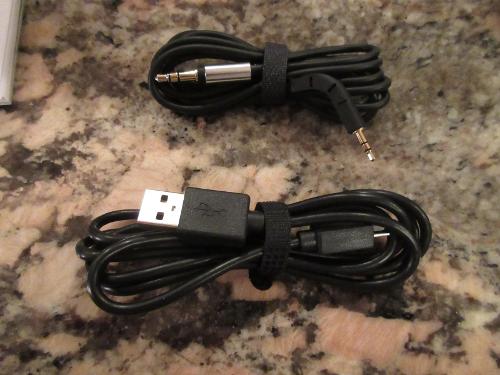

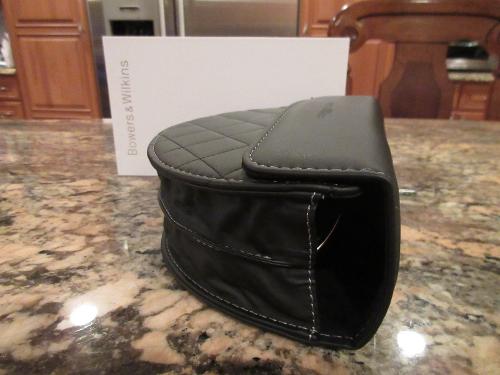
Design.
When it comes to a design, as I mentioned before in my other B&W reviews, all B&W headphones feature premium luxury details common across their different models, just scaled up or down depending on over-ear or on-ear design. You will find a genuine soft leather material covering memory foam of earpads, as well as the back of earcups covered in leather around a black brushed aluminum plate in the middle with an etched “Bowers & Wilkins” logo name.
Earcups are attached on one side to a solid curved chrome double metal rod that waves into the headband. Besides previously mentioned folding design, earcups themselves have a degree of tilt to adjust to your ears/head shape. The earpads are replaceable and attached magnetically to earcups, and I will cover more about it when discussing the cable attachment. One thing to mention, unlike P5W on-ear model where my ears did get warm after 20-30min of continuous use, with P7W over-ear model I didn't find this to be an issue.
The headband is leather wrapped and has a soft foam padding on the inner side. The whole construction felt very solid and relatively light with an evenly distributed 323 grams of weight. The headband height adjustment was buttery smooth while still requiring a little bit of force so it doesn't slide out loose. Clamping force was tight out of the box and required some break in period. After a few days it felt more comfortable while still offering a decent sound isolation which was better than on-ear P5W.


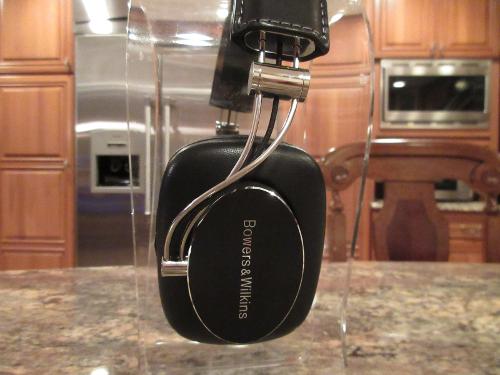
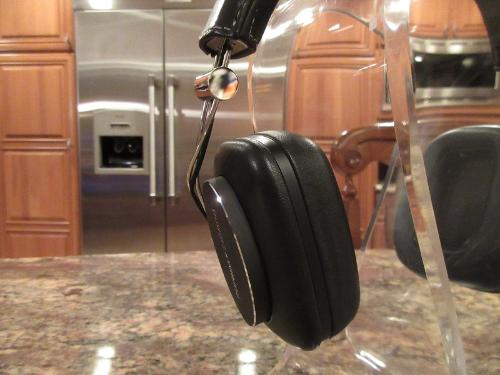







The fit.

Removable earpads and cable attachment.
P7W, being similar to P5W and their P5/P7 wired models, has a proprietary cable with a standard 3.5mm connector going to your audio source and 2.5mm angled connector going inside of the left earcup. It's a clever design which makes the cable appear like a permanent hardwired attachment. To get to the connector you will need to remove magnetically attached left earpad to gain access to internal 2.5mm socket. Right side earpad is magnetically attached as well for an easy replacement, just like the left earpad. I do want to comment about being careful if you have sharp nails so you don't damage the leather since these magnets are quite strong. The cable itself feels sturdy yet thin, flexible, and soft. Also, thanks to a connection going inside of the earcup, I didn't sense any microphonics effect.
Without a doubt, that is one clever way to attach a cable, but it's not as quick as just being able to plug in a cable directly, and fiddling with earpads could be a bit time consuming. But at the same time, I don't expect people constantly going back'n'forth between wired and wireless connection. It's definitely a huge plus if you run out of battery (17 hours on a single charge!!!), or if your source doesn't support wireless or you are in a place where wireless is not allowed.





Phone pair up and Controls.
The elegance of P7W design is complemented by its wireless controls, also identical to P5W. From a quick glance, you can't even see the buttons until you take a closer look. At the bottom of the right earcup there is a multi-function spring-loaded power button that turns headphones on/off when you slide and hold it, and goes into pair-up mode when you push it. All other functionality is taken care of by 3 control buttons conveniently located on the back of right earcup. All operations are accompanied by a pleasant chime tone feedback, instead of annoying voice commands used by many other headphones.
Pair up was easy and seamless, and headphones were connected to phone and media audio without any problem. As previously mentioned, the controls are within easy reach on the back of the right earcup, using 3 buttons with volume up/down assigned to the upper and the lower ones, and a raised button in the middle for Play/Pause/Call with a single click, Skip Next with a double click, Skip Back with a triple click, and long press to start Google NOW. The location of buttons on the back of earcup is very convenient and easy to ID by sliding a finger to find a middle button. The same right earcup has micro-usb charging port at the bottom next to the power button, a bi-color led, and two spread mic pinhole vents. Sound quality during calls was noted to be excellent.
With a support of the latest BT4.1, wireless performance was quite good covering a stutter free distance of up to 60 ft (!!!) in open space. Also, during a testing with my Note 4 in a pocket and while covering earcups with my hands, the wireless connection was still solid. A support of aptX, AAC, and SBC audio codecs yielded an excellent audio performance as well. If you are using Android based devices, aptX support is a must, though I have to admit that testing with aptX (Note 4) vs non-aptX (Opus#2 and X7) yielded a nearly identical sound results. Also, I noticed the same behavior as with P5W where as soon as you plug in the cable, wireless connection was automatically disabled.

Sound analysis.
Sound tuning of wireless headphones always takes an extra effort. While you still have two 40mm drivers with a nylon damped cone and CCAW coil, the sound no longer depends on the quality of the pair up source, but rather on the quality of internal D/A audio decoding of the digital stream. Under this operation, the source sends a digital data while internal sound processing decodes and converts it to analog signal pumping the drivers.
I put P7W through 100hrs of burn in prior to testing, and after close listening I hear a rich full body dynamic sound with a reversed-J fun signature. It's not quite L-shaped sound, though mid-bass slam is distinct and elevated, but you also have plenty of upper mids and treble smooth clarity and details, just not elevated enough to claim V-shaped sig though with enough treble quantity to lift that reversed-J tail.
The bass goes deep with sub-bass having a moderate balanced quantity without being too exaggerated. Mid-bass is where you get a serious rounded analog visceral slam, the kind you can expect from a full size floor speaker. It's powerful with a slower attack and a longer decay typical of a dynamic driver, but still under control without muddying the mids.
Lower mids have a full body, with a little extra thickness carried over from mid-bass, and a clear and detailed natural mids. We are not talking about analytical or crisp, these are full body organic clear mids with a natural tonality.
Treble has a nice definition and a modest sparkle, definitely not rolled off, though don't expect too much airiness. But it has just enough quantity to be noticed.
Soundstage is pretty wide for a closed back, definitely above average, but the depth/height are only average, making sound presentation more intimate while spreading it from left to right in front of you. The sound imaging is just OK, not the greatest due to a combination of closed back design and thicker sound which is a little more congested. I mean, there is no problem separating instruments and vocals, but accuracy of the positioning is not exactly on pin-point level.
These are fun tuned modern audiophile headphones that is not intended to Wow you with super transparency or surgical precision layering and separation of the sound. But the sound is rather clear and detailed, and there is no muddiness or veil. The tuning of these headphones is perfect for acoustic, instrumental, vocal, jazzy recordings. And switching to EDM and Pop will give you a taste of a full size speaker performance with a moderate basshead slam, a sound reminiscent of B&W reference loudspeakers. Also, they are fantastic for watching movies.
Wireless vs wired comparison.
In wired mode, where P7W has a very reasonable impedance of 22 ohms and 111dB sensitivity, the sound is nearly identical to wireless mode. The sound signature and even imaging are very similar. The only noticeable difference is that in Wireless mode I hear a little more mid-bass slam while in Wired it's less which makes sound more balanced.
In wired mode, it benefits greatly from a powerful source which scales up the sound to a more balanced signature with less mid-bass slam, better overall control of the bass, higher level of transparency, more airiness in treble, and better layering and separation of instruments. I actually really enjoyed pair up with Opus#2 and LPG.
One interesting observation, a regular non-wireless P7 has a sound signature closer to P7 (wireless), while P7 (wireless in wired mode) is more balanced with a bass under a better control.

Comparison.
P7W vs P5W - P5W has a more balanced signature, definitely lower quantity of sub-bass and mid-bass, a little more forward mids, while treble is the same. Overall, P7W sound is more detailed and has higher level of transparency and layering. Also, P7W has a wider soundstage, and better isolation.
P7W vs Momentum 2 Wireless - P7W has a stronger mid-bass punch and more body in lower mids, while M2W has a little more balanced low end and thinner lower mids and slightly more forward upper mids. Both have a sound with equal amount of detail retrieval and clarity, but P7W is a little more resolving. But overall, these two are not too far of each other in terms of sound tuning. Mid-bass dominance of P7W is the only major difference. Even soundstage is nearly the same.
P7W vs Pendulumic S1+ - S1+ has a more neutral bass and more forward upper mids, while treble is the same. P7W has a more fun signature with a harder bass slam and more resolving sound. S1+ actually sounds a little flatter and more congested in comparison. When it comes to soundstage, S1+ is tuned wider with more depth.

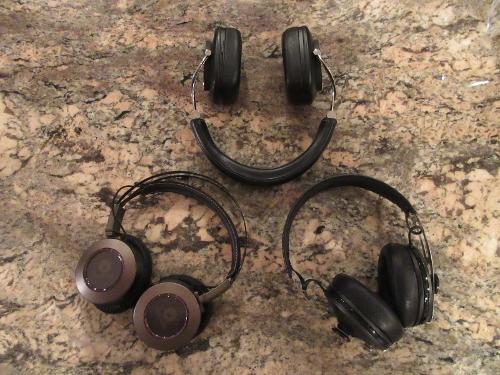
Conclusion.
The first and the most important point of my conclusion is that I no longer see the need to buy regular P7 headphones because P7 Wireless cost only $50 more and does both jobs great. You really do get 2 high performance headphones in one to use it connected directly to your favorite DAP or desktop setup as well as to your smartphone or Bluetooth enabled DAP. There are no compromises, with an exception of some mid-bass quantity variation.
So many times I get asked if buying a dedicated DAP or getting OTG USB DAC/amp will improve the sound quality of a particular smartphone. In case of B&W P7 Wireless you don't need an extra investment in order to drive these headphones to their full potential. All you need is a wireless source and you are set. Doesn't even have to be a smartphone or do you need to install a special sound enhancement app - any DAP w/Bluetooth should work. And vice versa, if you already have a desktop setup with your favorite tube amp - just connect the cable and enjoy P7W wired.

